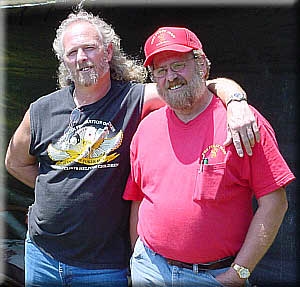Boilermaker And Laborer Goes "Wheels Off" With Mesothelioma
Marty Mitchell is a 48 year-old bricklayer and refractory mason who was born in Indianapolis, Indiana. He grew up in a crowded home, with six brothers and four sisters. Their dinner table was loud, with thirteen sets of tableware banging against plates and multiple conversations going on at the same time. This may seem too much for some, but for Marty, it was home sweet home.
As the seventh child, Marty learned at an early age what it meant to share, share a bedroom, share a wardrobe, share school supplies, share the back seat of Dad's car. Marty's father, Bert Mitchell, was a hard working, loving father who instilled a no-nonsense work ethic in his children at a young age. Bert was a bricklayer and refractory worker for years. He taught his children the importance of getting along as a family and putting in a full day's work. He also made sure they took the time to enjoy life as well.
The Mitchells were a family, they were a team, they were each other's worst enemies and best friends, built on compromise and cooperation.
A BAND OF HARD WORKING BROTHERS
After graduating high school at 1973, Marty went to work alongside five of his brothers. The Mitchell brothers worked as bricklayers, laborers, and boilermakers for much of the 1970s and 1980s. Like father, like sons. The brothers were well known for their quality of work and joy they took in their job. They worked out of local unions that shipped them to job sites all over the Midwest, including steel mills, aluminum plants, glass factories, blast furnaces and power houses. The brothers piled into their cars and drove in caravans to different jobs. If a car broke down en route, it was left on the side of the road and repaired on the way back. Like the Marine Corps, they lived by a code that championed the importance of team work and resilience.
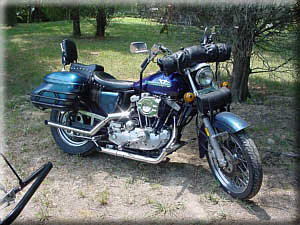
Before Marty headed to Detroit for surgery, he had 20 volunteers who offered to care for his Harley. They were all disappointed as Marty took the keys with him into the operating room.
At first glance, plant superintendents and job foremen would eyeball the Mitchells warily, as the brothers came across as disorganized - they seemed to be having too much fun, always laughing and cutting up. But when the whistle blew and it was time to punch the clock, the Mitchell brothers snapped to attention and worked harder and with more efficiency than any other group in the yard. The brothers were component parts of a well-oiled and seemingly indestructible machine
A HAPPY LIFE ON MITCHELL MOUNTAIN
Today, Marty lives on five acres on a hilltop in West Harrison, Indiana, which is just across the Ohio border in southeast Indiana. He's proud to call the hilltop his home (he affectionately refers to as "Mitchell Mountain") and is quick to point out that it is the second highest peak in Indiana. He has lived here for the past 20 years. The house lies off the road, meandering down a rock path through several rows of tall trees. Deer and other wildlife can be found on Mitchell Mountain, and a few times, the deer draw close enough to become Sunday dinner by way of Marty's arrow or muzzle loader (when in season, of course).
Marty's house serves as the official 'party' place for his family and friends. He hosts a Halloween party every year that has become legendary in West Harrison. His yard is full of witches, ghouls and goblins that if you look closely are actually his brothers, sisters, nieces, nephews or one of his three children or seven grandchildren.
Marty is quite the handyman and does all the repair work in his home as well as his neighbors'. When his children were younger, Marty built an impressive "fort" for his children with wood that he obtained from his brother's home. The fort resembles more of a log cabin, sturdy enough to house a small family. It has a front porch, electricity, a hinged front door and shuttered windows. Now that the kids are grown and moved away, Marty uses the fort to house a second refrigerator, to store his deer and turkey meat.
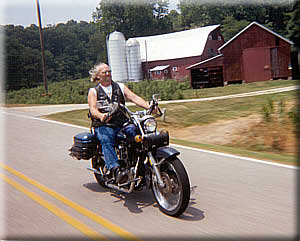
He just recently welded and installed a frame for his hard-case saddle bags for his Harley Davidson motorcycle. As you can tell, this is a man who loves to keep busy, who needs to keep busy. Marty frequently rides with the Scarecrows motorcycle club. Several times a year, the Scarecrows ride for a charity selected by the group.
MARTY'S LIFE TURNED UPSIDE DOWN
Everything in Marty's life was in order, everything was going great -- until December 15, 2001, when, as the saying goes, the wheels fell off.
That day, Marty broke his leg, just above the ankle. It was a compound fracture and the doctors did not place the leg in a cast, so therefore he was ordered to stay off the leg until it healed. Soon after, around early January, 2002 he developed flu-like symptoms. He also noticed that he was short of breath, which was unusual because he was still homebound due to his leg.
"MINOR" SYMPTOMS MASK A BIG PROBLEM
In February, 2002 he met with his family physician. Chest films were taken which revealed a left-sided pleural effusion. On February 19, Marty underwent a thoracentesis. Cytological tests upon the fluid removed from his chest cavity were negative for a malignancy. Marty was prescribed antibiotics and sent home.
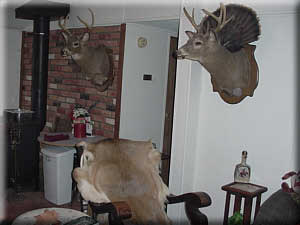 Around late April, Marty returned to his doctor, complaining that his chest was still hurting, he was still short of breath and still coughing. The doctors felt Marty was suffering from a sinus infection and prescribed antibiotics. They did not take any chest films.
Around late April, Marty returned to his doctor, complaining that his chest was still hurting, he was still short of breath and still coughing. The doctors felt Marty was suffering from a sinus infection and prescribed antibiotics. They did not take any chest films.
Four weeks passed and Marty returned, still complaining of chest pain. This time, chest films were taken and after reviewing them, Marty's doctor told him he could find nothing wrong with him and sent him home.
Another few weeks passed and for the fourth time since February, Marty met with his doctor, still complaining of a cough, pain and overall "tiredness." Another set of chest films were taken. The doctor compared them with the previous set and immediately informed Marty that they did not "look good." Marty asked him what he meant by that, but he was quickly referred to a cardiopulmonary specialist.
On July 15, a CT scan was taken which revealed an abnormal rind of nodular pleural thickening encasing the entire left hemithorax. The radiologist on duty told Marty that the pattern would be suggestive of diffuse pleural malignancy, namely, mesothelioma .
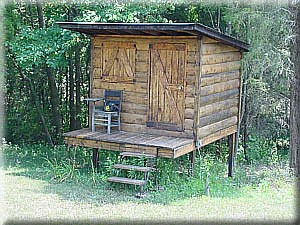
MESOTHELIOMA: What is that?
The cardiopulmonary specialist told Marty that after reviewing his records, it was his opinion that he was suffering from mesothelioma. He recommended that a biopsy be taken to be sure. On July 19, Marty underwent a CT-guided core biopsy of the left lung and pleura. Three 16-gauge core samples were obtained and sent for immunohistochemical analysis. The local pathologist examined the tissue sample and on July 19 diagnosed Marty with malignant mesothelioma.
Mesothelioma? Marty asked himself, "What is that?" He had never heard of it, but he knew from the way the doctors were looking at him that it couldn't be good. He immediately went on the Internet and researched as much as he could.
On July 25, Marty met with a local surgeon to discuss the diagnosis and his treatments. Surgery was an option. The surgeon suggested Marty meet with a local oncologist. During his research, Marty discovered Dr. Harvey Pass of the Karmanos Clinic in Detroit, Michigan, who is also a member of the Mesothelioma Applied Research Foundation ( MARF). Before making any treatment decisions with his local doctors, Marty wanted to meet with Dr. Pass first. He had gained the impression that Dr. Pass was tops in his field, and he wanted the best. Marty met with Dr. Pass on July 30th.
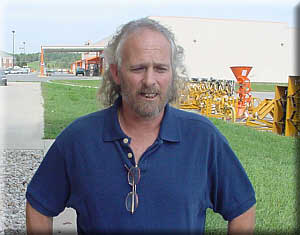
After reviewing his medical records and blood work, Dr. Pass felt Marty was an excellent candidate for an extra-pleural pneumonectomy, which includes the removal of his left lung, among other adjacent parts. The surgery was scheduled for August 23. Marty is optimistic about his chances, and feels that he has done all that he can do. Still, he's disenchanted - perhaps disgusted is a better word. He has learned that this risk was known by the asbestos companies for more 60 years ago, and was totally preventable, if not for the greed and inhumanity of a few. He speaks of inviting the CEOs and their lawyers to his surgery - "I don't want or care about their sympathy, but they should know the consequences of their pursuit of the almighty buck. I wonder how they would feel if they knew the only way they might survive is if a doctor ripped out their lung."
Unable to work since July, having filed for disability assistance, no longer contributing to his pension fund and having bills to pay, Marty wonders how he will make it through the rest of the year. His medical insurance will terminate in six months. How did all of this happen, and happen so quickly? One minute he was hunting deer and turkey with his brothers, the next minute is diagnosed with an incurable cancer and facing the removal of his lung. "What did I do wrong?" Marty asks himself.
You didn't do anything wrong Marty -- you were wronged. We will keep you posted on Marty's recovery.
*** POSTED AUGUST 21, 2002 ***
An Update -- 10/9/02
On August 23, Marty underwent a left thoracotomy, extra-pleural pneumonectomy, reconstruction of his diaphragm with a Gore-Tex patch, lymph node dissection and a partial pericardiectomy. At the start of the surgery, Dr. Pass removed the sixth rib in order to obtain access to Marty's thoracic cavity. He immediately encountered an incredibly thick, bulky tumor with endothoracic-fashion invasion at multiple sites. The tumor was so massive, Dr. Pass decided to open the diaphragm first and work from the bottom to the top, a path not normally taken. After the surgery, Marty remained in the hospital for several more days.
On September 1, he was discharged but remained in Detroit. On September 3, he was readmitted for increased swelling in his left lower leg. An ultrasound was performed which showed a deep venous thrombosis of his calf vein. He was treated with anticoagulants, including Coumadin, and released two days later. Marty then made the long drive home to Mitchell Mountain.
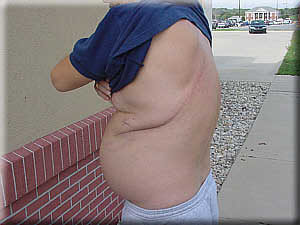
Marty is slowly recovering from the surgery. He has lost nearly 30 pounds since the diagnosis. He is unable to chop the firewood necessary to keep his home warm for the upcoming winter. He also worries that perhaps he should find a warmer location to sit out the cold, bitter, Indiana winters.
His friends and family have chipped in to help him with household chores that Marty enjoyed doing himself, including mowing the three acres of grass surrounding his home, keeping the house clean, fixing meals and doing the laundry. He has never had to rely on anyone before and feels terrible about putting his his family and friends through this.
This past weekend, Marty was unable to participate in the latest charity ride of the Scarecrows. Not wanting to be left completely out, he volunteered to help sell tee-shirts at one of the stops on the ride.
We will continue to follow this warrior thoughout his recovery.
Mr. Marty Mitchell passed away on May 10, 2003

